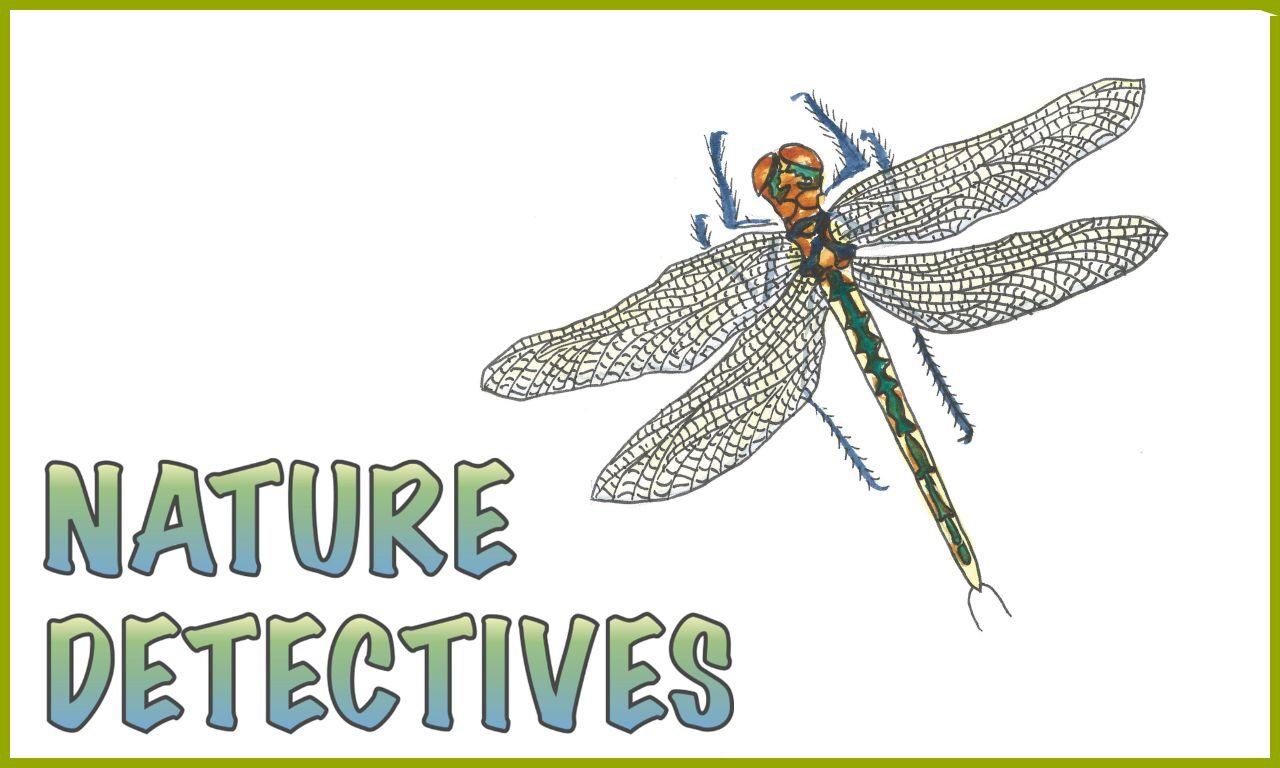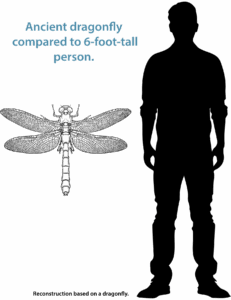Summer is here, and the amazing dragonflies are emerging to show off their beauty and superpowers. You can watch them dart across ponds, lakes, wetlands, and open meadows as they hunt — moving forward, backward, up, down, and hovering in a beautiful dance right before your eyes.
Ancient Dragonflies: Older Than the Dinosaurs
The ancestor to the dragonfly, called a griffonfly, lived 350 million years ago. Most dinosaurs roamed the earth between 250 and 65 million years ago — that’s 100 million years after the first dragonflies appeared. Only a few other animals, such as crocodiles, sharks, and horseshoe crabs, still look like their ancient ancestors.
The griffonfly looked very much like today’s dragonfly only much, much bigger! A griffonfly could have a wingspan, from the tip of one wing to the tip of the other wing, of more than 2 feet long (24 inches). That would be about the same size as a magpie’s wingspan. The common green darner, the biggest dragonfly in Colorado today, has a wingspan of about 3 inches.
Ancient dragonfly superpower: Dragonflies have changed very little over 350 million years.
Beginning Life in the Pond
We may see many colors of adult dragonflies flying around, but they begin life in the water. Dragonflies lay their eggs on plants in the water, also known as aquatic plants. When the eggs hatch, they become larvae — also called nymphs — that breathe underwater with gills.
The nymphs begin hunting by lying in wait to ambush their prey. They grow as they eat other water insects, tadpoles and even small fish. As they grow, they get too big for their skin, like how you outgrow your clothes. The skin of insects is called an exoskeleton; it’s a hard outter layer that protects their body. As dragonfly nymphs outgrow their exoskeletons, they shed the old hard shells. Then they let a new soft skin underneath harden. Each skin shedding is called a molt, and dragonfly larvae may molt five to 15 times while living in the water from a few months to over five years. The nymphs are great predators and have these superpowers to help them eat:
- Larva Superpower #1: They have excellent sight under water.
- Larva Superpower #2: They have hairlike structures on their legs and antennae. So, when prey passes, they can sense the water moving nearby.
- Larva Superpower #3: Their extendable lower jaw can reach out and grab prey.
- Larva Superpower #4: Some dragonflies capture prey, or escape enemies, with jet propulsion, using squirts of water.
The Change Begins
So how does a dragonfly go from living at the bottom of the pond to being a bright flyer above the pond? They go through metamorphosis. Metamorphosis is a series of physical changes an animal goes through to become an adult.
When the time is right, the dragonfly nymph crawls up the grass, cattail, or log and leaves the pond. Once the nymph leaves the pond, it goes through metamorphosis and molts one last time.
This time, when it breaks out of its skin, it doesn’t look like a larger nymph — it looks completely different. The new adult has two sets of wings, a longer and more colorful body, and large eyes. Once its wings and body dry, it’s ready to fly.
- Metamorphosis Superpower #1: Changing from breathing with gills underwater to breathing with their body in the air.
- Metamorphosis Superpower #2: Changing from hunting under the water to hunting in the air.
- Metamorphosis Superpower #3: Using daylight and water temperature to know when to change.
Ready to Fly
Once its body and wings dry, the new adult dragonfly takes flight. Dragonflies are amazing flyers! They are the fastest of all the flying insects — some dragonflies can fly up to 35 miles per hour. Dragonflies can also hover, staying in one place above the ground or water for a long time.
Activity: The next time you’re in the car with your parents, ask them when they are driving 35 miles an hour to see how fast that is.
This ability to fly makes them great predators, and we are very lucky they are good hunters. Why? Dragonflies eat other flying insects. One adult dragonfly can eat a huge number of flying insects a day. Lucky for us, one of their favorite foods is mosquitoes. So, if you are sitting at a park in the evening, you can be very happy to see dragonflies zooming around you.
- Adult Superpower #1: They can fly forward, backward, up, down, and even upside down! Each of their four wings has its own muscles, allowing each wing to move on its own. Which means they can stop fast, then turn in place.
- Adult Superpower #2: Their large eyes can see almost in a full circle. They can see more colors than humans and can even see ultraviolet light like bees.
- Adult Superpower #3: Some kinds of dragonflies migrate south for the winter. Like Monarch butterflies, it is their children or grandchildren that migrate north again.
Even More Reasons to Appreciate Dragonflies
Dragonfly nymphs prefer to live in cleaner water. So, if you see dragonflies living near a wetland or pond, you know that water is not highly polluted.
They are good pest control. They hunt flying insects like mosquitoes, wasps, and midges. They also are a valuable food source for other animals like birds, fish, frogs, and spiders.
They come in many sizes, colors, and patterns — and are wonderful to watch as they fly over ponds and parks.
Just like many birds, many male and female dragonflies of the same species look different. Not only can the males be bright colored and the females duller colored, but some dragonfly males are one bright color, and the female of the same species is another bright color.
Dragonflies are related to damselflies. Both dragonflies and damselflies are in the order of insects Odonata. Damselflies are as beautiful as dragonflies but look more delicate and are not such strong flyers.
Print this edition’s Nature Detective activity: Dragonfly and Damselfly Scavenger Hunt!
Or print the entire edition!
Nature Detectives Library
Every past issue of Nature Detectives can be found in the Nature Detectives Library!





